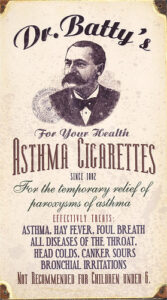There was a time when smoking was not just a widespread habit, but one that was actually promoted by the medical community. Advertisements featuring doctors confidently recommending cigarettes as safe – and even beneficial – were fairly common. Only a few decades later, the devastating health consequences of smoking are incredibly well known, with lung cancer being one of the most common diseases linked to cigarette use. This shift in awareness took years, as initial warnings were overlooked and scientific consensus was slow to form. Today, we may be witnessing a similar situation with electromagnetic fields (EMFs).
EMFs have become an unavoidable part of our modern existence, generated by devices ranging from cell phones and Wi-Fi routers to power lines. Despite their omnipresence, the potential health risks associated with prolonged EMF exposure are still hotly debated and not fully understood. Just as it took years for the dangers of smoking to be recognized, the true impact of EMFs on both our health and the environment might not be fully appreciated for some time – and by then, many may have suffered unnecessary consequences.
The Road to Recognition of Cigarette Dangers
In the early 20th century, smoking was more than just a habit – it was a status symbol, representing modernity and sophistication. Advertisements of the time often depicted smoking as both glamorous and beneficial to health, with endorsements from doctors and celebrities. This societal acceptance created an environment where the risks associated with smoking were not just ignored – they were actively denied.

The Medical Community’s Early Views
During this era, the medical community had little understanding of the health risks posed by smoking. Despite growing evidence linking smoking to lung disease, these warnings were largely dismissed. Early studies suggesting harm were overshadowed by the prevailing belief in the safety of cigarettes, largely, of course, reinforced by financial interests.
Changing Perceptions Over Time
It wasn’t until the mid-20th century that pivotal studies provided undeniable evidence of the link between smoking and serious health issues like lung cancer. As the scientific evidence mounted, public health campaigns began to change the narrative. Regulatory measures soon followed, including warning labels on cigarette packaging, advertising restrictions, and widespread public health initiatives aimed at reducing smoking rates.
The transition from widespread acceptance to the recognition of smoking’s dangers was slow and met with a lot of resistance. This history illustrates the challenges of translating scientific discoveries into public health measures and the profound impact that delay can have on public well-being.
Understanding EMFs
Electromagnetic fields (EMFs) are essentially invisible energy zones, also commonly referred to as radiation, which stem from the use of electrical power and various forms of natural and artificial lighting. EMFs are classified into two main types: ionizing and non-ionizing radiation. Ionizing radiation, such as X-rays and gamma rays, has enough energy to remove electrons from atoms and has a clear potential to cause harm. Non-ionizing radiation, which includes EMFs from cell phones, Wi-Fi routers, and power lines, has less energy and is often considered less harmful, though research into its more subtle effects is still ongoing.
Common Sources of EMF Exposure
In our technology-centered world, EMFs are everywhere. We are constantly exposed to these fields from an increasing amount of sources, including:
- Cell Phones and Smartphones: These emit radiofrequency
 EMFs during calls, texts, and data usage.
EMFs during calls, texts, and data usage. - Wi-Fi Routers: These devices create a network of radiofrequency EMFs to facilitate wireless internet connections.
- Power Lines: These generate low-frequency EMFs as electricity is transmitted from power plants to homes and businesses.
- Household Appliances: Everyday items like microwaves, televisions, and hairdryers emit varying levels of EMFs.
As technology has proliferated, so too has our exposure to EMFs. From wearable devices to smart home technology, our modern lifestyle is deeply intertwined with EMF-emitting gadgets. While these technologies bring convenience, they also raise important questions about the long-term health implications of manipulating our energetic environment in such a massive way
Emerging Health Concerns
With our increasing reliance on EMF-emitting technology, the body of research examining potential health impacts is growing. Numerous studies have explored the links between EMF exposure and various health concerns, including:
- Cancer Risk: Some research suggests a possible link between long-term EMF exposure and an increased risk of cancers like brain tumors. However, these findings remain controversial, with many studies producing inconclusive or conflicting results.
- Neurological Effects: EMF exposure may impact brain activity, sleep patterns, and cognitive functions. There are concerns that long-term exposure, particularly in children, could affect brain development and function.
- Reproductive Health: Studies have indicated potential effects on fertility and reproductive health, with some evidence that EMF exposure could impact sperm quality and pregnancy outcomes.
Despite these concerns, the scientific community is not in full agreement. Many studies have limitations, and the diversity in results makes it challenging to draw definitive conclusions. The complexity of EMF exposure – encompassing different frequencies, intensities, and durations – adds to the difficulty of establishing clear cause-and-effect relationships.
Comparison to Early Cigarette Research
The current state of EMF research bears striking resemblances to the early days of research into smoking. Initially, studies linking smoking to lung cancer were met with skepticism and resistance. The influence of the tobacco industry and the slow accumulation of

conclusive evidence delayed public awareness and health warnings.
Similarly, EMF research faces skepticism, conflicting interests, and the inherent challenge of proving long-term health impacts. The precautionary principle, which advocates for taking preventive action in the face of uncertainty, is often overshadowed by demands for definitive proof. This situation mirrors the early attitudes towards smoking, where the lack of immediate, overwhelming evidence allowed harmful practices to continue.
The Slow Pace of Science and Public Health Recommendations
One of the most significant challenges in public health is the time it takes for scientific research to inform health recommendations. The process of gathering solid evidence, undergoing peer review, and achieving consensus can take decades. This delay was evident in the case of cigarettes, where early warnings were disregarded for years due to the lack of conclusive evidence and the powerful influence of the tobacco industry.
In the case of EMFs, we see a similar slow progression towards scientific consensus. Despite growing concerns and initial studies suggesting potential health risks, the evidence is often viewed as insufficient to warrant immediate public health actions. The variation in study designs, exposure levels, and health outcomes further complicates the process of establishing clear guidelines.
The Consequences of Delay
 The delayed acknowledgment of the dangers of smoking resulted in millions of lives lost to preventable diseases like lung cancer and heart disease, while the scientific community and public health authorities debated the evidence. This history underscores the human cost of waiting for definitive proof and “official recommendations” before taking preventive action.
The delayed acknowledgment of the dangers of smoking resulted in millions of lives lost to preventable diseases like lung cancer and heart disease, while the scientific community and public health authorities debated the evidence. This history underscores the human cost of waiting for definitive proof and “official recommendations” before taking preventive action.
Similarly, the potential risks associated with prolonged EMF exposure might not be fully recognized until many people have suffered the consequences. Without timely and precautionary measures, individuals may continue to experience avoidable health problems. The current, more tedious approach, reminiscent of the early days of cigarette research, leaves the public vulnerable to risks that could be mitigated with earlier intervention.
Learning from History
The history of cigarettes offers a crucial lesson in the importance of proactive public health strategies, even when scientific uncertainty remains. Applying the precautionary principle – taking preventive action in the presence of potential risks without waiting for conclusive evidence – can help protect public health. Regarding EMFs, this might involve:
- Raising Public Awareness: Educating people about the potential risks of EMF exposure and practical ways to reduce it.
- Encouraging Further Research: Supporting independent studies to better understand the health and environmental impacts of EMFs.

Save 25% on all Aires Tech Lifetune products with code “CLP” - Implementing Precautionary Measures: Recommending practical steps to minimize EMF exposure, such as using wired connections, limiting cell phone use, keeping electronic devices away from sleeping areas, and using EMF protection – like the ones made by Aires Tech – to mitigate excessive exposure.
By learning from the past and applying these insights to the present, we can better navigate the uncertainties surrounding EMFs and protect our health and the environment for the future.
Closing Thoughts
Looking back at the slow recognition of the dangers of smoking, we see a cautionary tale for our current handling of EMFs. The delayed response to early warnings about smoking led to widespread suffering and

preventable diseases. Today, we find ourselves in a similar situation with EMFs, where the science is still evolving and public health recommendations are conservative.
To learn from history, we must advocate for a more proactive approach to EMF exposure. By raising awareness, supporting research, and taking personal precautions, we can safeguard our health and the health of future generations. While it may take years for science to provide definitive answers, we have the power to act now and reduce potential risks.
The lesson from cigarettes is clear: waiting for conclusive proof and “official recommendations” from bureaucratic institutions can come at a significant cost. By embracing the precautionary principle and taking preventive action today, we can help mitigate potential risks associated with EMF exposure. As we continue to navigate the complexities of modern technology, let’s prioritize health and well-being and strive for a safe and healthy future for everyone.


 EMFs during calls, texts, and data usage.
EMFs during calls, texts, and data usage.






